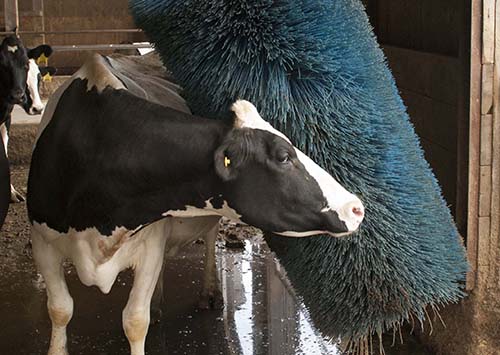
Cows spend their days doing core activities, like sleeping and eating, and luxury activities, like playing and exploring. Luxury activity will decline when time or energy resources are limited during stress or illness.
One luxury item growing in popularity is the automated cow brush. Brushes are typically installed to help keep cows clean, potentially raise milk yield and to enrich the environment. Could the use, or lack of use, of a brush tell us how a cow is feeling? Some researchers think so.
An Israeli study conducted by Roi Mandel and others published in the Journal of Dairy Science took a look at how feed location, temperature and stress impacted brush use. Brushing activity was recorded for a 56-day period. About 70 percent of cows used the brush daily, for an average of 4.5 times per day. Brushing activity grew as the day went on and reached a peak about 6 p.m.
Cows were fed twice daily, on either the side of the barn where the brush was installed, on the side opposite the brush, or on both sides. Feed location significantly impacted brush use. The brush was used by 81 percent of cows when feed was available on the brush side. Sixty-eight percent used it when feed was available on both sides, and just 53 percent used it when feed was on the opposite side. The number of brushing events per day was highest when feed was available on the brush side.
Throughout the experiment, temperature heat index (THI) was between 56 and 77°F. On days when feed was opposite the brush, THI was negatively correlated with brush use. THI did not have a significant impact on days when feed was available on the brush side or on both sides. Overnight, brush use grew as THI rose when cows were fed on the brush side.
The day when a pregnancy check or breeding took place saw an average 35 percent reduction in brush activity. The effect after a pregnancy check was not significant, but brush use was substantially less after breeding. This could have been a result of stress from both rectal and vaginal intrusions (compared to just rectal for pregnancy checks) or estrous behavior that may have taken away from other activities.
These early results supported the researchers' hypothesis that brush use would decline due to stress or illness. This behavioral change could make it a potential indicator for earlier disease detection and more effective treatments in the future.
 The author is an associate editor and covers animal health, dairy housing and equipment, and nutrient management. She grew up on a dairy farm near Plymouth, Wis., and previously served as a University of Wisconsin agricultural extension agent. She received a master's degree from North Carolina State University and a bachelor's from University of Wisconsin-Madison.
The author is an associate editor and covers animal health, dairy housing and equipment, and nutrient management. She grew up on a dairy farm near Plymouth, Wis., and previously served as a University of Wisconsin agricultural extension agent. She received a master's degree from North Carolina State University and a bachelor's from University of Wisconsin-Madison.









